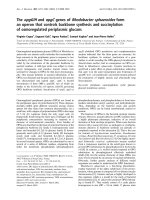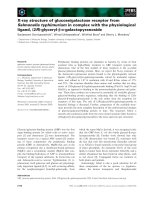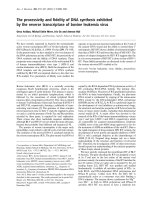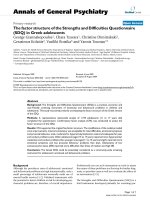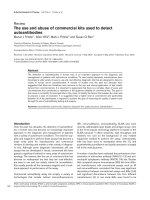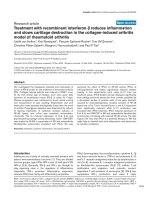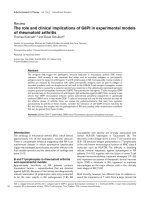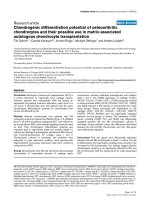Báo cáo y học: "The factor structure of the Strengths and Difficulties Questionnaire (SDQ) in Greek adolescents" potx
Bạn đang xem bản rút gọn của tài liệu. Xem và tải ngay bản đầy đủ của tài liệu tại đây (227.7 KB, 7 trang )
BioMed Central
Page 1 of 7
(page number not for citation purposes)
Annals of General Psychiatry
Open Access
Primary research
The factor structure of the Strengths and Difficulties Questionnaire
(SDQ) in Greek adolescents
George Giannakopoulos
1
, Chara Tzavara
1
, Christine Dimitrakaki
1
,
Gerasimos Kolaitis
2
, Vasiliki Rotsika
3
and Yannis Tountas*
1
Address:
1
Centre for Health Services Research, Department of Hygiene, Epidemiology and Medical Statistics, Athens University Medical School,
Athens, Greece,
2
Department of Child and Adolescent Psychiatry, Athens University Medical School, "Agia Sophia" Children's Hospital, Athens,
Greece and
3
Department of Psychiatry, Community Mental Health Center Byron-Kesariani, University of Athens, Athens, Greece
Email: George Giannakopoulos - ; Chara Tzavara - ; Christine Dimitrakaki - ;
Gerasimos Kolaitis - ; Vasiliki Rotsika - ; Yannis Tountas* -
* Corresponding author
Abstract
Background: The Strengths and Difficulties Questionnaire (SDQ) is a practical, economic and
user-friendly screening instrument of emotional and behavioural problems in children and
adolescents. This study was aimed primarily at evaluating the factor structure of the Greek version
of the SDQ.
Methods: A representative nationwide sample of 1,194 adolescents (11 to 17 years old)
completed the questionnaire. Confirmatory factor analysis (CFA) was conducted to assess the
factor structure of the SDQ.
Results: CFA supported the original five-factor structure. The modification of the model provided
some improvements. Internal consistency was acceptable for total difficulties, emotional symptoms
and prosocial behaviour scale, moderate for hyperactivity/inattention scale and inadequate for peer
and conduct problems scale. Older adolescents (aged 15 to 17 years) reported more hyperactivity/
inattention and conduct problems than younger ones (aged 11 to 14 years) and girls reported more
emotional symptoms and less prosocial behaviour problems than boys. Adolescents of low
socioeconomic status (SES) reported more difficulties than those of medium and high SES.
Conclusion: The Greek SDQ could be potentially considered as a community-wide screening
instrument for adolescents' emotional and behavioural problems.
Background
Although the prevalence rates of adolescents' emotional
and behavioural problems are high internationally, only a
small percentage of adolescents eventually make use of
mental health services [1,2]. Validated instruments with
the potential to detect children at risk for developing psy-
chosocial problems are, therefore, of crucial importance.
Professionals can use such instruments as tools to assess
the nature of these problems as a first step for further diag-
nosis, to prioritise cases as well as to evaluate the effects of
an intervention [3-5].
The Strengths and Difficulties Questionnaire (SDQ) is a
brief instrument developed primarily for screening pur-
Published: 26 August 2009
Annals of General Psychiatry 2009, 8:20 doi:10.1186/1744-859X-8-20
Received: 4 June 2009
Accepted: 26 August 2009
This article is available from: />© 2009 Giannakopoulos et al; licensee BioMed Central Ltd.
This is an Open Access article distributed under the terms of the Creative Commons Attribution License ( />),
which permits unrestricted use, distribution, and reproduction in any medium, provided the original work is properly cited.
Annals of General Psychiatry 2009, 8:20 />Page 2 of 7
(page number not for citation purposes)
poses, such as selecting at risk cases for further assessment
and treatment [6]. The SDQ has been translated into more
than 40 languages in recent years, meeting the need for a
practical, economic and user-friendly instrument. Ver-
sions are available for self-reporting by 11 to 16 year olds
as well as for parents and teachers of 4 to 16 year olds. The
SDQ, compared to other similar instruments such as the
Child Behaviour Checklist (CBCL) [7], seems equally
valid for most clinical and research applications [4,8-10].
Additionally, the SDQ is much shorter in format and
quick in completion time and as such more convenient
for epidemiological studies and screening of large groups
of children from the general population. However, the
CBCL has been shown to be more appropriate for the
investigation of a broader range of psychopathology [9].
The originally proposed factor structure of the SDQ
includes five scales of five items each, corresponding with
the domains of psychopathology and personal strengths it
intends to measure [6]. These scales generate scores for
conduct problems, hyperactivity/inattention, emotional
symptoms, peer problems, and prosocial behaviour. A
total difficulties score is calculated by totalling the four
adjustment problems scales (that is, all except for proso-
cial behaviour). An extended version of the SDQ includes
an impact supplement that enquires further about chro-
nicity of the problems, distress, social impairment and
burden for others.
A number of mainly European studies have provided con-
sistent support for its proposed five-factor structure [11],
although numerous secondary loadings mainly on the
prosocial behaviour factor or limited associations
between the item 'I usually do as I am told' and the theo-
retically associated conduct problems factor have been
reported [5,12-14]. Other studies have failed to replicate
the originally hypothesised five-factor structure [15,16].
However, few studies have used confirmatory analytic
techniques to evaluate the original hypothesised factor
structure of the SDQ [17-21].
Similar to the findings concerning the SDQ factor struc-
ture, there is a substantial body of rather varied research
with regard to other psychometric properties of the instru-
ment [5,10,22-26].
In Greece, few published studies have investigated emo-
tional and behavioural problems among school-aged
children and adolescents [27] due to the relative lack of
screening instruments that have been developed or
adapted in the Greek language against agreed scientific
attributes [28-32]. As the European interest in mental
health prevention and health promotion services is
expanding, availability of good quality instruments at a
national level becomes ever more necessary. The present
study is the first to examine the factor structure of the SDQ
through confirmatory analytic techniques.
Methods
Participants and procedures
This study was conducted in the year 2003 within the
framework of the European project 'Screening and Pro-
motion for Health-Related Quality of Life (HRQoL) in
Children and Adolescents A European Public Health Per-
spective' [33]. The school sampling in Greece was ran-
dom, multistaged and performed to take into account
distribution of the target population by age and adminis-
trative school region. The target population was adoles-
cents aged 11 to 17. A sample size of 1,800 adolescents
was considered necessary to detect a minimally important
difference of half a standard deviation (SD) in HRQoL
scores within each age strata between children with and
without special healthcare needs or a chronic condition. A
response rate of approximately 70% was expected, so the
initial sample size was set at 2,400 children and adoles-
cents. In Greece, ages 11 to 17 correspond to six secondary
school grades. Approximately 400 students were included
from each of the 6 age groups/grades in order to reach the
original target of 2,400 adolescents. For example, the total
number of students in Greece attending the first grade of
the secondary school is 119.055. If an administrative
region had a total number of 2,174 students attending the
first grade of the secondary school then 8 students were
randomly recruited from a school in that region ((2,174 ×
400)/119,055 = 7.6 students). Each age group/grade had
been calculating accordingly, for each sector. Schools in
each sector were randomly selected by a computer pro-
gram and students of each selected school were selected
randomly from classroom name lists. A sample of 1,900
adolescents (11 to 17 year olds) was recruited. A total of
1,194 (that is, a 63% response rate) of self-reported ques-
tionnaires (479 boys and 715 girls) were returned. Total
adolescent sample mean age was 13.6 years (SD = 1.7).
Regarding the socioeconomic status (SES) characteristics
of the sample, 37.59% came from low-income families,
44.96% came from middle-income families and 17.45%
from high-income families. Students were asked to com-
plete the questionnaire at home after providing written
informed consent. Inclusion criteria were adequate read-
ing skills. Previous research on the representativeness of
the present sample has reported that non-responder inter-
views showed no significant differences between respond-
ers and non-responders with regard to adolescents' and
parents' general perceived health, parents' marital status
and highest educational level, and type of residence, indi-
cating that a selection bias is less likely [33].
Measures
The SDQ contains 25 items (small sentences), categorised
into 5 scales of 5 items each: hyperactivity/inattention,
Annals of General Psychiatry 2009, 8:20 />Page 3 of 7
(page number not for citation purposes)
emotional symptoms, conduct problems, peer problems
and prosocial behaviour [6]. Responses to each of the 25
items consisted of 3 options: not true, somewhat true, or
certainly true. For all scales the items that are worded neg-
atively are assigned scores of 2 for certainly true, 1 for
somewhat true, and 0 for not true. The version for youths
was used in the present study. In order to combat inherent
weaknesses of crosscultural adaptation (for example,
semantic and scale equivalence) the research team in the
present study followed a standardised translation meth-
odology according to international crosscultural transla-
tion guidelines [34]. To assess familial SES, the Family
Affluence Scale (FAS) [35] was used, addressing issues of
family car ownership, having their own unshared room,
the number of computers at home and times the children
spent on holiday in the past 12 months. The FAS was col-
lected in seven categories (from 0 the lowest to 7 the high-
est) and was re-coded into three groups for the analysis
(low FAS level (0 to 3), intermediate (4 to 5) and high (6
to 7)). The psychometric properties of the FAS are accept-
able and support its use as a self-reported adolescents'
measure [36].
Statistical analysis
Confirmatory factor analysis (CFA) with maximum likeli-
hood procedure was used to assess the theoretical model
for the SDQ proposed by Goodman [13]. For all models,
independence of error terms was specified, and the factors
were allowed to be correlated. A number of approaches
were used to assess the fit of the CFA models, including
the comparative fit index (CFI), the goodness of fit index
(GFI), the χ
2
goodness of fit test and the root mean square
error of approximation (RMSEA) [37]. There are a variety
of guidelines for interpreting the fit of a specific model
based on these indices. For the CFI and GFI indices, values
close to or greater than 0.95 are taken to reflect a good fit
to the data [38]. RMSEA values of less than 0.05 indicate
a good fit, and values as high as 0.08 indicate a reasonable
fit [38]. CFA was carried out using the SPSS AMOS pack-
age (SPSS, Chicago, IL, USA).
Internal consistency reliability was determined by calcula-
tion of the Cronbach α coefficient. A minimum reliability
of 0.70 for measures used in-group comparisons has been
recommended [39]. Multivariate analysis of variance
(MANOVA) using the Tukey correction for multiple com-
parisons was used to explore differences on SDQ scales
according to gender and age groups, as well as differences
on SDQ scales according to SES.
Results
CFA
Fit indices resulting from the CFA for the five-factor
hypothesised model were estimated. The CFI, GFI and
RMSEA values were 0.78, 0.91 and 0.057, respectively,
indicating a questionable fit. Factor loadings were evenly
distributed from 0.19 to 0.66. A further analysis was per-
formed according to modification index (MI), which was
used to suggest potential improvements to the model. The
MI is employed to measure how much the χ
2
test is
reduced when a particular change in the model is sug-
gested. A large sample size can make even a small MI value
significant. Therefore, only the largest MI is analysed in
this text. Estimates of the modified model are presented in
Table 1. The item 'I usually do as I am told' loaded mod-
erately (with a loading of 0.19) on the conduct problems
scale and had secondary loadings of -0.25 on emotional
symptoms scale. The item 'I think before I do things' had
loading equal to 0.25 on hyperactivity/inattention scale
and a secondary loading was added on prosocial behav-
iour scale (with a loading of -0.23). The modification
indices also suggested an additional error covariance
between the items 'I am easily distracted; I find it difficult
to concentrate' and 'I finish the work I am doing; my
attention is good'. An additional error covariance was also
observed between the items 'I am restless; I cannot stay
still for long' and 'I am constantly fidgeting or squirming'.
These findings indicated that the aforementioned items
create a subdimension within the hyperactivity/inatten-
tion factor. After the effects of modification, CFA revealed
an acceptable fit according to the following results for CFI,
GFI and RMSEA: 0.92, 0.95, and 0.04, respectively.
Internal consistency reliability
The internal consistency coefficient for the total difficul-
ties score was 0.77. Cronbach α values for the prosocial
behaviour, emotional symptoms and hyperactivity/inat-
tention were 0.72, 0.73 and 0.63, respectively. The lowest
α was found on the peer problems scale (0.50) and con-
duct problem scale (0.56).
Effects of age, gender and SES
According to the MANOVA results (Table 2), girls
reported higher mean scores on the emotional symptoms
and prosocial behaviour scales. Age differences revealed
that those aged 15 to 17 years reported higher mean scores
on the conduct problem and hyperactivity/inattention
scales compared to those aged 11 to 14 years. The score on
the prosocial behaviour scale was lower in children aged
15 to 17 years than those aged 11 to 14 years. A gender/
age interaction was found for the emotional symptoms
scale. Females had higher scores on the emotional symp-
toms scale than males and this difference was greater in
the age group of 15 to 17 years than in the age group of 11
to 14 years.
MANOVA showed significant differences in SDQ scores
between adolescents of low versus high SES and low ver-
sus medium SES (Table 3), except for the conduct prob-
lems and prosocial behaviour scores. No significant
Annals of General Psychiatry 2009, 8:20 />Page 4 of 7
(page number not for citation purposes)
differences were obtained between adolescents of high
versus medium SES.
Discussion
The main objective of the present study was to investigate
the originally proposed five-factor structure of the self-
report Greek SDQ. The analysis confirmed the proposed
five-factor structure of the instrument [13], although
some modifications seemed to be necessary in order to
gain an acceptable model fit.
The present report is one of the few studies that has used
confirmatory analytical techniques to evaluate the origi-
nal hypothesised factor structure of the SDQ. Dickey and
Blumberg [17] could not entirely confirm the predicted
five-component structure of the parent-report SDQ and
extracted a stable three-factor model consisting of exter-
nalising problems, internalising problems, and a positive
behaviour factor. A Dutch study of parent and teacher
reports [18] showed that the model with five latent varia-
bles outlined by Goodman fitted only moderately well,
whereas the model with three latent variables (that is,
externalising behaviour, internalising behaviour, and
prosocial behaviour) did not show better fit indices. Three
studies have reported confirmatory factor analyses of the
self-report SDQ. A study in a general population of Rus-
sian adolescents [19] concluded that the proposed five-
factor solution had inadequate psychometric properties
with low factor loadings and scale reliabilities (0.44 to
0.70). Similarly, an Irish study in a community-based
Table 1: Parameter estimates from the results of confirmatory factor analyses of the Strengths and Difficulties Questionnaire (SDQ)
five-dimensional model
Prosocial Hyperactivity Emotional Conduct problems Peer problems
I try to be nice to other people. I care about their feelings. 0.58
I usually share with others (food, games, pens and so on). 0.43
I am helpful if someone is hurt, upset or feeling ill. 0.64
I am kind to younger children. 0.48
I often volunteer to help others (parents, teachers, and/or children). 0.66
I am restless; I cannot stay still for long. 0.46
I am constantly fidgeting or squirming. 0.55
I am easily distracted; I find it difficult to concentrate. 0.51
I think before I do things. -0.23 0.25
I finish the work I am doing. My attention is good. 0.44
I get a lot of headaches, stomach aches or sickness. 0.41
I worry a lot. 0.59
I am often unhappy, downhearted or tearful. 0.65
I am nervous in new situations. I easily lose confidence. 0.46
I have many fears, I am easily scared. 0.51
I get very angry and often lose my temper. 0.64
I usually do as I am told. -0.25 0.19
I fight a lot. I can make other people do what I want. 0.44
I am often accused of lying or cheating. 0.58
I take things that are not mine from home, school or elsewhere. 0.49
I am usually on my own. I generally play alone or keep to myself. 0.53
I have one good friend or more. 0.42
Other people my age generally like me. 0.43
Other children or young people pick on me or bully me. 0.46
I get on better with adults 0.41
Table 2: Means and standard deviations (SD) of the Strengths and Difficulties Questionnaire (SDQ) scales
11 to 14 years 15 to 17 years
Total Male Female Male Female
Prosocial behaviour
a
8.1 ± 1.8 7.9 ± 2.0 8.4 ± 1.6 7.5 ± 2.1 8.2 ± 1.8
Hyperactivity
b
3.6 ± 2.2 3.1 ± 2.2 3.1 ± 2.1 3.9 ± 2.2 4.1 ± 2.2
Emotional symptoms
abc
3.0 ± 2.1 2.3 ± 2.2 3.1 ± 2.0 2.5 ± 2.0 3.7 ± 2.1
Conduct problems
b
2.0 ± 1.5 3.0 ± 1.7 2.8 ± 1.4 3.0 ± 1.5 3.1 ± 1.5
Peer problems 1.8 ± 1.7 1.9 ± 2.0 1.7 ± 1.6 1.9 ± 1.8 2.0 ± 1.6
a
P <0.05 for gender differences;
b
P <0.05 for age differences;
c
significant gender/age interaction.
Annals of General Psychiatry 2009, 8:20 />Page 5 of 7
(page number not for citation purposes)
education sample reported many deviations from the
hypothesised component structure of the self-report SDQ,
particularly in relation to the reverse-coded items [20].
Unlike the above-mentioned findings, D'Acremont and
Van der Linden [21] suggested a reliable factor organisa-
tion of the French version of the teacher-report SDQ with
acceptable to very good scale reliabilities (0.64 to 0.90).
In the present study, consistent with previous research
[5,12,14], the item 'I usually do as I am told' showed lim-
ited association with the originally associated conduct
problems scale. In fact, being obedient seemed to be
indicative of more emotional symptoms in the present
population, suggesting possible cultural differences in the
interpretation of this item content. Moreover, the item 'I
think before I do things' was found to load moderately on
the originally associated hyperactivity/inattention scale
and load more strongly on the prosocial behaviour scale.
This finding has been reported elsewhere [5,12,14,20]
and lends further support to previously reported devia-
tions from the originally proposed structure in relation to
the reverse-coded items (that is, positively worded items
of adjustment problems scale). It could be suggested that
a more valid scoring procedure in the Greek population
may exclude the aforementioned items (that is, 'I usually
do as I am told' and 'I think before I do things') from the
scoring system. Furthermore, the hyperactivity/inatten-
tion scale appeared to be divided into two subdimensions
(that is, hyperactivity and inattention). This finding may
reflect the inability to assess the multidimensional atten-
tion deficit hyperactivity disorder through only five items
different in nature to each other [20].
With regard to the internal consistency of the instrument,
Cronbach α values for the total difficulties, emotional
symptoms, and prosocial behaviour scales were found to
be above the minimum recommended level of 0.70 indi-
cating acceptable internal consistency. However, internal
consistency for the hyperactivity/inattention scale was
moderate and a low α was revealed for peer and conduct
problems scales, agreeing well with other research
[11,13,16,19,20,22].
Previous studies on the SDQ [10,22-24] have consistently
shown that adolescent girls report more emotional symp-
toms and less prosocial behaviour problems than boys,
while boys have a higher score on conduct and peer prob-
lems scales. Parents seem to report less prosocial behav-
iour problems for their adolescent daughters and more
hyperactivity/inattention for their adolescent sons
[10,24,25]. Moreover, analyses on the age effects on the
SDQ scales scores provide somewhat mixed findings
depending mainly on cultural differences. However, stud-
ies do suggest that during adolescence, hyperactivity/inat-
tention and peer problems significantly decrease with age,
while emotional symptoms increase, especially in girls
[5,22,23,26]. Finally, it has been reported that adolescents
with a less favourable social and economic background
show significantly more total difficulties and score signif-
icantly higher on the hyperactivity/inattention and peer
problems scales of the SDQ [26]. However, some studies
have not shown a marked effect of family economic dis-
advantage on adolescents' emotions or behaviour [25].
The present analysis revealed that girls reported higher
prosocial behaviour and more emotional symptoms
(increasing with age); this finding is consistently sup-
ported by previous research [10,23,24]. However, unlike
results from other studies [5,22,26], it is interesting that in
the present sample older adolescents (attending mainly
senior high school) reported more hyperactivity/inatten-
tion and conduct problems than those aged 11 to 14
(attending mainly junior high school). The particular edu-
cational circumstances in Greece may be involved in the
observed differences and the effect of the extremely com-
petitive and stressful school environment in Greek senior
high schools, due to the intensive 3-year preparation for
the entry university exams, should be further explored in
Table 3: Differences in Strengths and Difficulties Questionnaire (SDQ) scales according to family affluence level
Family affluence scale (FAS)
Low (0 to 3) Medium (4 to 5) High (6 to 7)
Mean
T value
SD Mean T value SD Mean T value SD
Emotional symptoms
ab
51.82 10.04 49.28 9.76 48.60 9.94
Conduct problems 50.49 10.02 49.55 10.28 50.39 9.35
Hyperactivity
ab
51.20 9.35 50.08 9.78 49.21 10.43
Peer problems
ab
51.69 10.60 48.91 9.57 48.77 9.14
Prosocial behaviour 50.61 9.40 49.36 10.39 49.63 10.77
a
P < 0.05 for differences between low and medium;
b
P < 0.05 for differences between low and high.
SD = standard deviation.
Annals of General Psychiatry 2009, 8:20 />Page 6 of 7
(page number not for citation purposes)
future research. By contrast, the current results were in the
expected direction in terms of family SES, with adoles-
cents coming from a lower socioeconomic background
reporting more emotional and behavioural problems
[25,26].
Conclusion
The present study lends further support to Goodman's
five-factor structure via confirmatory factor analytic tech-
niques, suggesting that the original component scales may
be appropriate for a sample of Greek adolescents. A scor-
ing procedure that better reflects some modifications in
the factor structure of the instrument may improve the
ability of school practitioners and clinicians to screen for
emotional and behavioural problems among Greek ado-
lescents. It is worth mentioning, however, that the results
of this analysis may not be well generalised to clinical
samples, as the current study employed a school-based
population. The utility of the self-report SDQ in Greek
clinical samples of adolescents and the discriminant
validity remain to be examined.
Competing interests
The authors declare that they have no competing interests.
Authors' contributions
GG, CT, CD, GK and VR participated in the preparation of
the paper. YT had overall supervision of the study.
References
1. Bird HR: Epidemiology of childhood disorders in a cross-cul-
tural context. J Child Psychol Psychiatry 1996, 37:35-49.
2. Davis H, Cox A, Day C, Roberts R, Loxton R, Ispanovic-Radojkovic
V, Tsiantis J, Layiou-Lignos E, Puura K, Tamminen T, Turunen M-M,
Paradisiotou A, Hadjipanayi Y, Pandeli P: European Early Promo-
tion Project Primary Health Care Worker Training Manual.
Belgrade: Institute of Mental Health; 2000.
3. Achenbach TM: Diagnosis, assessment, taxonomy, and case
formulations. In Handbook of child psychopathology Edited by: Ollen-
dick TH, Hersen M. New York, USA: Plenum Press; 1998:63-87.
4. Klasen H, Woerner W, Wolke D, Meyer R, Overmeyer S, Kaschnitz
W, Rothenberger A, Goodman R: Comparing the German ver-
sions of the Strengths and Difficulties Questionnaire (SDQ-
Deu) and the Child Behavior Checklist. Eur Child Adolesc Psychi-
atry 2000, 9:271-276.
5. Muris P, Meesters C, Berg F van den: The Strengths and Difficul-
ties Questionnaire (SDQ) further evidence for its reliability
and validity in a community sample of Dutch children and
adolescents. Eur Child Adolesc Psychiatry 2003, 12:1-8.
6. Goodman R: The Strengths and Difficulties Questionnaire: a
research note. J Child Psychol Psychiatry 1997, 38:581-586.
7. Achenbach TM: Manual for the Youth Self Report and 1991
profile. Burlington, VT, USA: University of Vermont, Department of
Psychiatry; 1991.
8. Bourdon KH, Goodman R, Rae DS, Simpson G, Koretz DS: The
Strengths and Difficulties Questionnaire: U.S. normative
data and psychometric properties. J Am Acad Child Adolesc Psy-
chiatry 2005, 44:557-564.
9. Goodman R, Scott S: Comparing the Strengths and Difficulties
Questionnaire and the Child Behavior Checklist: is small
beautiful? J Abnorm Child Psychol 1999, 27:17-24.
10. Koskelainen M, Sourander A, Kaljonen A: The Strengths and Dif-
ficulties Questionnaire among Finnish school-aged children
and adolescents. Eur Child Adolesc Psychiatry 2000, 9:277-284.
11. Hawes DJ, Dadds MR: Australian data and psychometric prop-
erties of the Strengths and Difficulties Questionnaire. Aust
NZ J Psychiatry 2004, 38:644-651.
12. Capron C, Therond C, Duyme M: Brief report: effect of
menarcheal status and family structure on depressive symp-
toms and emotional/behavioural problems in young adoles-
cent girls. J Adolesc 2007, 30:175-179.
13. Goodman R: Psychometric properties of the strengths and dif-
ficulties questionnaire. J Am Acad Child Adolesc Psychiatry 2001,
40:1337-1345.
14. Smedje H, Broman JE, Hetta J, von Knorring AL: Psychometric
properties of a Swedish version of the "Strengths and Diffi-
culties Questionnaire". Eur Child Adolesc Psychiatry 1999, 8:63-70.
15. Ronning JA, Handegaard BH, Sourander A, Morch WT: The
Strengths and Difficulties Self-Report Questionnaire as a
screening instrument in Norwegian community samples. Eur
Child Adolesc Psychiatry 2004, 13:73-82.
16. Thabet AA, Stretch D, Vostanis P: Child mental health problems
in Arab children: application of the strengths and difficulties
questionnaire. Int J Soc Psychiatry 2000, 46:266-280.
17. Dickey WC, Blumberg SJ: Revisiting the factor structure of the
strengths and difficulties questionnaire: United States, 2001.
J Am Acad Child Adolesc Psychiatry 2004, 43:1159-1167.
18. van Leeuwen K, Meerschaert T, Bosmans G, De Medts L, Braet C:
The Strengths and Difficulties Questionnaire in a commu-
nity sample of young children in Flanders. Eur J Psychol Asses
2006, 22:189-197.
19. Ruchkin V, Koposov R, Schwab-Stone M: The Strength and Diffi-
culties Questionnaire: scale validation with Russian adoles-
cents. J Clin Psychol 2007, 63:861-869.
20. Percy A, McCrystal P, Higgins K: Confirmatory factor analysis of
the adolescent self-report Strengths and Difficulties Ques-
tionnaire. Eur J Psychol Assess 2008, 24:43-48.
21. D'Acremont M, Linden M Van der: Confirmatory factor analysis
of the Strengths and Difficulties Questionnaire in a commu-
nity sample of French-speaking adolescents. Eur J Psychol Assess
2008, 24:
1-8.
22. Koskelainen M, Sourander A, Vauras M: Self-reported strengths
and difficulties in a community sample of Finnish adoles-
cents. Eur Child Adolesc Psychiatry 2001, 10:180-185.
23. Van Roy B, Groholt B, Heyerdahl S, Clench-Aas J: Self-reported
strengths and difficulties in a large Norwegian population
1019 years: age and gender specific results of the extended
SDQ-questionnaire. Eur Child Adolesc Psychiatry 2006, 15:189-198.
24. van Widenfelt BM, Goedhart AW, Treffers PD, Goodman R: Dutch
version of the Strengths and Difficulties Questionnaire
(SDQ). Eur Child Adolesc Psychiatry 2003, 12:281-289.
25. Marzocchi GM, Capron C, Di Pietro M, Duran Tauleria E, Duyme M,
Frigerio A, Gaspar MF, Hamilton H, Pithon G, Simões A, Thérond C:
The use of the Strengths and Difficulties Questionnaire
(SDQ) in Southern European countries. Eur Child Adolesc Psychi-
atry 2004, 13(Suppl 2):II40-46.
26. Woerner W, Becker A, Rothenberger A: Normative data and
scale properties of the German parent SDQ. Eur Child Adolesc
Psychiatry 2004, 13(Suppl 2):II3-10.
27. Bibou-Nakou I, Kiosseoglou G, Stogiannidou A: Strengths and dif-
ficulties of school-aged children in the family and school con-
text. Psychology 2001, 8:506-525.
28. Scientific Advisory Committee of the Medical Outcomes Trust:
Assessing health status and quality-of-life instruments:
Attributes and review criteria. Qual Life Res 2002, 11:193-205.
29. Giannakopoulos G, Kazantzi M, Dimitrakaki C, Tsiantis J, Kolaitis G,
Tountas Y: Screening for children's depression symptoms in
Greece: the use of the Children's Depression Inventory in a
nation-wide school-based sample. Eur Child Adolesc Psychiatry
2009, 18:485-92.
30. MacDonald VM, Tsiantis J, Achenbach TM, Motti-Stefanidi F, Richard-
son SC: Competencies and problems reported by parents of
Greek and American children, ages 611. Eur Child Adolesc Psy-
chiatry 1995, 4:1-13.
31. Roussos A, Karantanos G, Richardson C, Hartman C, Karajiannis D,
Kyprianos S, Lazaratou H, Mahaira O, Tassi M, Zoubou V: Achen-
bach's Child Behavior Checklist and Teachers' Report Form
in a normative sample of Greek children 612 years old. Eur
Child Adolesc Psychiatry 1999, 8:165-72.
Publish with Bio Med Central and every
scientist can read your work free of charge
"BioMed Central will be the most significant development for
disseminating the results of biomedical research in our lifetime."
Sir Paul Nurse, Cancer Research UK
Your research papers will be:
available free of charge to the entire biomedical community
peer reviewed and published immediately upon acceptance
cited in PubMed and archived on PubMed Central
yours — you keep the copyright
Submit your manuscript here:
/>BioMedcentral
Annals of General Psychiatry 2009, 8:20 />Page 7 of 7
(page number not for citation purposes)
32. Roussos A, Francis K, Zoubou V, Kiprianos S, Prokopiou A, Richard-
son C: The standardization of Achenbach's Youth Self-
Report in Greece in a national sample of high school stu-
dents. Eur Child Adolesc Psychiatry 2001, 10:47-53.
33. Rajmil L, Berra S, von Rueden U, Tebe C, Erhart M, Gosch A, Alonso
J, Bisegger C, Ravens-Sieberer U: Representativity of 12 national
surveys of children and adolescents 818 years old included in
the KIDSCREEN HRQoL study. Qual Life Res 2004, 13:1576.
34. Bullinger M, Anderson R, Cella D, Aaronson N: Developing and
evaluating cross-cultural instruments from minimum
requirements to optimal models. In The international assessment
of Health-related Quality of Life Edited by: Shumaker SA, Berzon RA.
New York, USA: Oxford Rapid Communications; 1995:83-91.
35. Currie CE, Elton RA, Todd J, Platt S: Indicators of socioeconomic
status for adolescents: the WHO Health Behaviour in
School-aged Children Survey. Health Educ Res 1997, 12:385-397.
36. Boyce W, Torsheim T, Currie C, Zambon A: The Family Affluence
Scale as a measure of national wealth: Validation of an ado-
lescent self-reported measure. Soc Indic Res 2006, 78:473-487.
37. Mueller RO: Basic principles of structural equation modeling.
New York, USA: Springer; 2000.
38. Hu L, Bentler PM: Cutoff criteria for fit indices in covariance
structure analysis: conventional criteria versus new alterna-
tives. Structural Equation Modeling 1999, 6:1-55.
39. Nunnally JC, Bernstein IR: Psychometric theory. New York, USA:
McGraw-Hill Book Company; 1994.
